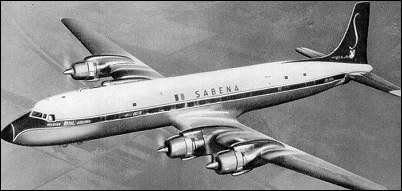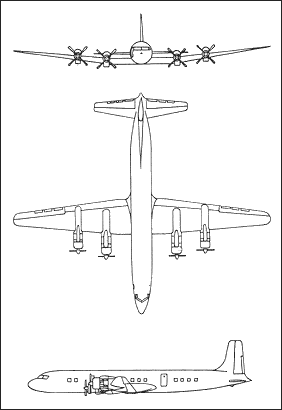 |
Douglas DC-71953 |  |
| PASSENGER | Virtual Aircraft Museum / USA / Douglas |
 |
Design and development of the Douglas DC-7 were prompted by American Airlines, which was seeking an aircraft superior in performance to the Lockheed Super Constellation being used by TWA. The Super 'Connie' benefitted from the use of new Wright Turbo-Compound engines, each of which had three exhaust-driven turbochargers giving some 20 per cent more output than the standard unit, and to meet the requirement of American Airlines it was decided to develop an improved version of the DC-6B using this new powerplant. The initial DC-7 was a direct development of the DC-6B, with the fuselage lengthened by 1.02m to allow for the inclusion of an additional row of seats. Installation of the 2424kW R-3350 Turbo-Compound engines made possible an increase in gross weight of 6895kg, and required some strengthening of the landing gear structure. There were also some minor changes in detail, but externally the DC-7 appeared little different from the DC-6B. A total of 105 DC-7s was built, and the 112 DC-7B aircraft which followed showed only minor changes. Most importantly, the engine nacelles were extended further aft to permit the installation of saddle tanks within the rear of the nacelles (which were made of the new metal titanium). Not all operators opted for this additional fuel capacity, but those who did, such as Pan American which inaugurated non-stop London-New York services with the DC-7B on 13 June 1955, soon discovered that fuel capacity was marginal for North Atlantic services. In fact, with a full load and normal headwinds, DC-7Bs which were.used to operate the east-to-west service frequently had to divert for a refuelling stop. This was clearly unsatisfactory, and potentially dangerous, and Douglas set about the task of developing a version of the DC-7B with greater range. The third version was designated DC-7C and had, therefore, increased span to provide for greater fuel capacity. This was achieved by inserting a new parallel-chord wing section between the fuselage and the inboard engine nacelles, which had the added advantage of improving the cabin environment by reducing engine noise. During the development of the DC-7C, Curtiss-Wright was able to offer a further increase in engine power and, as a result, the fuselage was lengthened by the insertion of a 1.02m plug to provide accommodation for up to 105 passengers. Production of DC-7Cs totalled 120, and the alphanumeric suffix of this version became corrupted most appropriately to Seven Seas, for this aircraft wasabie to take the oceans in its stride without any problems. Not only were they used on North Atlantic and Pacific Ocean services, but they also made possible non-stop scheduled operations across the continental USA, and were used also by SAS to inaugurate a Europe-to-Far East route over the North Pole. An improved DC-7D was planned, to be powered by four 4273kW Rolls-Royce Tyne turboprop engines, but the emergence of the Boeing 707 and the Douglas Company's purpose-built DC-8 jetliner meant that this remained only as an unfulfilled project. Because the turbo-compound engine increased operating costs, these fine air-liners disappeared quickly from the aviation scene when replaced by the first turboprop- and turbojet-powered airliners.
|  COMPANY PROFILE | |||||||||||||||||||||||||||||||||||||||||||||||||||||||||||||
 |

|

